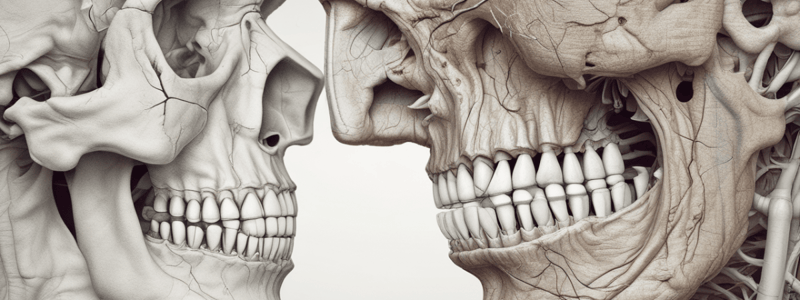Podcast
Questions and Answers
What is the approximate capacity of the maxillary sinus?
What is the approximate capacity of the maxillary sinus?
- 5 ml
- 15 ml (correct)
- 10 ml
- 20 ml
When do maxillary sinuses develop during intrauterine life?
When do maxillary sinuses develop during intrauterine life?
- Third month (correct)
- Sixth month
- First month
- Ninth month
What is the shape of the maxillary sinus?
What is the shape of the maxillary sinus?
- Spherical
- Cylindrical
- Pyramidal (correct)
- Conical
What is the purpose of the ostium maxillare?
What is the purpose of the ostium maxillare?
At what stage of life do maxillary sinuses reach their adult size?
At what stage of life do maxillary sinuses reach their adult size?
What is the direction of the longer dimension of the maxillary sinus at birth?
What is the direction of the longer dimension of the maxillary sinus at birth?
What happens to the growth of the maxillary sinus during puberty?
What happens to the growth of the maxillary sinus during puberty?
What is the size of the maxillary sinus at birth?
What is the size of the maxillary sinus at birth?
What is the direction of the apex of the maxillary sinus?
What is the direction of the apex of the maxillary sinus?
Which of the following is NOT a function of the maxillary sinus?
Which of the following is NOT a function of the maxillary sinus?
Where does the maxillary sinus open into the nasal cavity?
Where does the maxillary sinus open into the nasal cavity?
Which of the following teeth is rarely associated with the floor of the maxillary sinus?
Which of the following teeth is rarely associated with the floor of the maxillary sinus?
What type of mucous membrane lines the maxillary sinus?
What type of mucous membrane lines the maxillary sinus?
What is the structure of the antral mucous membrane?
What is the structure of the antral mucous membrane?
Which wall of the maxillary sinus forms the floor of the orbit?
Which wall of the maxillary sinus forms the floor of the orbit?
Which of the following is a deciduous tooth that is rarely associated with the floor of the maxillary sinus?
Which of the following is a deciduous tooth that is rarely associated with the floor of the maxillary sinus?
Flashcards are hidden until you start studying
Study Notes
Maxillary Sinus
- Largest bilateral air sinus in the body, located in the maxilla bone
- Opens into the middle nasal meatus of the nasal cavity with single or multiple openings called ostium maxillare
- Average dimensions: 3.5 cm (anteroposterior) x 3.2 cm (height) x 2.5 cm (width)
- Average capacity: approximately 15 ml
Development
- Develops at the third month of intrauterine life as an evagination of the mucous membrane of the lateral wall of the nasal cavity
- Enlarges primarily in an inferior direction into the primordium of the maxilla
- Reaches adult size by the eruption of the permanent teeth
Growth of Maxillary Sinus
- Enlargement is consequent to facial growth
- Growth slows down during puberty but continues throughout life
- At birth, the sinus has the size of a small lima bean (8X4 mm) and is situated with its longer dimension directed anteriorly and posteriorly
Anatomy
- Pyramidal in shape with a base, an apex, and four walls
- Base: lateral wall of the nasal cavity
- Apex: directed laterally towards the zygomatic process of the maxilla
- Four walls: anterior (facial surface of the maxilla), posterior (infratemporal surface of the maxilla), roof (floor of the orbit), and floor (alveolar process of the maxilla)
Function of the Maxillary Sinus
- Lightening the weight of the skull
- Resonance of voice
- Olfactory and respiratory modulations through regulation of air pressure during respiration
- Inspired air conditioning
- Craniofacial protection against mechanical trauma
- Production of bactericidal enzyme (lysozyme) for protection against bacterial infection of the nasal mucosa
Opening of Maxillary Sinus
- Opens into the nasal cavity through the ostium, an opening found on the highest part of the medial wall of the sinus
Floor of the Sinus
- The permanent teeth that may be related to the floor of the sinus are: first molar, second and third molars, second and first premolars, and rarely the canine
- Deciduous teeth that may be related to the floor of the sinus are: D, E, and rarely C
Histology of the Maxillary Sinus
- Lined with a mucous membrane of the respiratory type, which is somewhat thinner than that lining the nasal cavity
- Antral mucous membrane is formed of: an epithelial layer, a basement membrane, and a subepithelial connective tissue layer
Studying That Suits You
Use AI to generate personalized quizzes and flashcards to suit your learning preferences.




